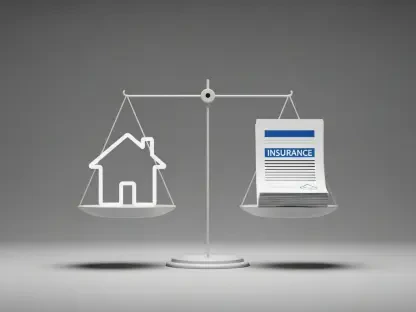Africa’s insurance market is undergoing a fundamental transformation, witnessing a robust growth trajectory that signals a potential digital revolution. It is projected to reach USD 160.9 billion by 2033, increasing from USD 92.9 billion in 2024, thanks to a compound annual growth rate (CAGR) of 6.03% from 2025 onward. This significant shift is fueled by the continent’s economic development, regulatory reforms, and technological advancements. As a growing middle class emerges, there is a parallel increase in disposable income, leading to a heightened demand for insurance products. These dynamic changes are crucial in driving both the current and future expansion of Africa’s insurance market, offering a landscape rich with opportunity and innovation.
Economic Development and Regulatory Reforms
Rising Middle Class and Financial Literacy
The considerable growth in Africa’s middle-class population is a major driver of the rising demand for insurance products across the continent. This expanding demographic is characterized by increased disposable incomes, which in turn amplifies the need for financial services such as insurance. The economic uplift experienced by many African nations is pivotal, with more families attaining middle-class status and seeking protection for their growing assets and sources of income. Moreover, the continent is witnessing enhanced financial literacy driven by comprehensive educational campaigns. These initiatives underscore the significance of insurance for asset protection and long-term financial security, encouraging more individuals to actively seek out and invest in such products. Life insurance, in particular, is in high demand given that it accounts for a substantial 68% of the market in some leading regions.
Regulatory reforms and government initiatives are also playing a vital role in the insurance sector’s evolution. Many African governments are creating more conducive environments for insurance by simplifying entry for new and innovative companies. This is achieved through the development of favorable policies that support mandatory vehicle and health insurance, thereby expanding the reach of basic coverage. Additionally, governments are working toward greater consumer protection and enforcement, making insurance accessible to a wider audience. Some countries, like Kenya, stand out in their openness to private sector participation, fostering conditions that attract international investors. Large-scale initiatives like subsidized agricultural insurance and public-private partnerships are making inroads into underserved markets, such as those for smallholder farmers and small to medium-sized enterprises (SMEs), which represent significant potential for sector growth.
Technological Innovations in Insurtech
Digital technology is proving to be a game-changer in Africa’s insurance industry, especially with the rapid adoption of insurtech solutions. The continent has become a fertile ground for technological advancement, with digital platforms and mobile applications democratizing access to insurance services. The landscape is marked by insurtech startups that are leveraging technology to enhance the accessibility and affordability of insurance, particularly in countries where smartphone usage is prevalent. One notable example is Kenya’s Blue Wave, which offers microinsurance solutions through mobile devices. This model lowers costs for consumers and allows wide-reaching service delivery that caters to mass markets. Other programs, like BimaLab, have spurred the creation of numerous insurtech products, broadening market penetration and significantly increasing user bases.
Mobile-based claims processing, usage-based telematics, and AI-driven customer interactions are reshaping consumer experiences, drawing in previously hesitant individuals. Even with penetration rates hovering at just 3% of Africa’s GDP, these digital innovations indicate enormous growth potential. They promise to reach untapped populations, offering customized insurance packages that cater to the specific needs and challenges facing different communities. This technological evolution not only streamlines insurance processes but also aligns with the increasing demand for fast, easy-to-access services, paving the way for enhanced market participation and financial inclusion across the continent.
Diverse Insurance Offerings and Market Adaptation
Digitalization and Consumer Engagement
The ongoing digital transformation is redefining the interactions between insurance companies and consumers in Africa. Digital strategies are enabling direct-to-consumer models, which facilitate the purchase and management of policies entirely online. In countries like Kenya and Nigeria, for instance, insurtech companies are forming partnerships with telecommunications operators to distribute microinsurance and health products. These agreements reduce traditional bureaucratic processes, easing onboarding and premium collection even in remote regions. This elevated accessibility is crucial, as it extends formal insurance services to millions of previously underserved individuals, dramatically narrowing the customer acquisition gap.
Customization is an emerging trend, with consumers demanding tailored solutions that adapt to their distinct needs. Microinsurance is thriving, offering affordable and succinct coverage suitable for a variety of risks. This model is particularly attractive to the agricultural sector and SMEs, which face climate-driven threats and fluctuating economic conditions. Efforts like the Africa Climate Risk Insurance Facility for Adaptation are focused on addressing significant protection gaps, such as the estimated $100 billion annual financing shortfall for smallholder farmers, by developing products that cover weather-related crop losses. Takaful, or Islamic insurance, is another blossoming market segment, rooted in principles of mutual responsibility and catered to the sizable Muslim population. These developments reflect a broader shift within the industry toward affordability, flexibility, and culturally aligned services.
Challenges and Opportunities Ahead
The advancement of Africa’s insurance market is not without its challenges, as the sector contends with several persisting issues. Low disposable income levels still limit purchasing power for many Africans, creating a barrier to further insurance adoption. There also exists a deep-seated mistrust in formal insurance systems, which can diminish consumer confidence and impede market growth. Nevertheless, the introduction of microinsurance products, paired with strategic digital-first approaches, is helping to mitigate these hurdles. These innovative solutions are instrumental in extending coverage to previously excluded groups, fostering credibility and trust.
Partnerships between traditional insurers and non-traditional entities such as technology firms are gaining momentum, offering novel avenues for service delivery and customer engagement. These alliances are poised to significantly enhance market dynamics, unlocking new opportunities for sector expansion. They hold the potential to introduce more dynamic and personalized offerings, catering to a diverse and youthful African demographic that is urbanized and technologically advanced. The insurance industry in Africa is undergoing significant change, laying the foundations for sustained growth and future resilience.
Strategic Pathways for Future Growth
Africa’s insurance sector is experiencing a transformative phase, marked by strong growth that hints at an impending digital revolution. Forecasts predict the market will soar to USD 160.9 billion by 2033 from USD 92.9 billion anticipated in 2024, spurred by a compound annual growth rate (CAGR) of 6.03% from 2025 onward. This remarkable progression is propelled by the continent’s economic advancement, modifications in regulatory frameworks, and leaps in technology. With the rise of a middle class, there’s an increase in disposable income, boosting demand for various insurance offerings. Such vibrant changes are pivotal to the current and prospective enlargement of Africa’s insurance domain, presenting a variety of opportunities for development and pioneering innovations. Stakeholders are encouraged to take note of these shifts, given that they hold the potential to reshape the landscape, making it a fertile ground for investment and collaboration amid a digital transformation that looms on the horizon.









